
We know how you feel. You’re busy creating amazing content for your Facebook page, you’ve created polls and videos, gifs and links, but now you’re asking yourself, when is the best time to post all of this juicy content?
Should you just wing it and see what happens? Should you meticulously plan every single post time? Does it even matter anymore? Aren’t we at the mercy of the Facebook Algorithm Overlords… ok, maybe that was too far, but maybe also not entirely unjustified.
Figuring out the best time to post on Facebook, or any of your social media platforms can feel a bit like trying to solve Pythagoras theorem with an abacus. You’ll always be one step behind the big bad tech company and their big scary algorithm, just waiting to bring you down. Are we right?
Yes and no. We’re not saying that the Facebook Algorithm doesn’t make it tricky to figure these things out, and we’re definitely not saying it’s as easy as post every Tuesday at 2 pm. In this article, we’re planning to go for a bit of a deep dive into the hows, the wheres, the whens, and the whys about getting your posts to land at the right time (and to the right people!).
Hang in there; we’ve got you.
The Best Time To Post on Facebook
Like all things social media, there is no easy answer to the ‘best times to post on Facebook’ question, much as we wish there was! In fact, due to the changes Facebook regularly makes, it can sometimes feel like it’s never been more challenging to find the right time to post, but we’ve read all the studies and done a bucket of research to see if we can help you narrow down a time slot that will help.
If you’re looking for a quick answer to the question, we’ve found that, globally, the best time to post on Facebook is around 1 to 3 pm on both Thursdays and Fridays.
What does this mean for you? Well, you could take this information and just stick to posting on Thursdays and Fridays, but studies show that, in general, 1 pm - 3 pm on weekdays and on Saturdays is generally a good time to send your posts out.
We pulled together a list of the best days to post on Facebook to give you a bit of a starting point for your posts:
- The best time to post on Facebook on Monday - between 8 am and 10 am with another peak at 1 pm
- The best time to post on Facebook on Tuesday - 10 am and between 1 pm and 2 pm
- The best time to post on Facebook on Wednesday - between 9 am and 3 pm with the hours of 9 am, 11 am and between 1 pm to 2 pm being the highest for engagement
- The best time to post on Facebook on Thursday - between 10 am and 2 pm
- The best time to post on Facebook on Friday - between 9 am and 11 am
- The best time to post on Facebook on Saturday - between 9 am and 10 am
- The best time to post on Facebook on Sunday - between 9 am and 2 pm
It’s worth noting here that, although there were some peaks on both Saturday and Sunday, they were both much lower than weekdays. As we discussed on our Best Times To Post on Instagram blog, though, Sundays are a bit of a dead day for social media in general, and Facebook was no exception.
Picking a global time, however, isn’t the best idea. The best idea is to pick the right time for you and your brand. There are many ways to find out what the best time for your brand is, especially if your account has been going for any length of time - you can use your insights analytics data to find out exactly when is the best time.
If you are a brand new brand and you’d like to gain a bit of an insight into what are the general best times for your industry, we found some data that may be of some use to you:
- Consumer Goods - Wednesdays at 1 pm and Fridays at 11 am, avoid Sundays
- Media Companies - Tuesdays, Wednesdays, and Thursdays at 5 pm, and Fridays from 8 am to 9 am, avoid Sundays
- Educational Content - Wednesdays at 9 am and Saturday at 5pm, avoid Sundays
- Nonprofits - Wednesdays and Fridays between 8 am and 9 am, avoid the weekends
- Tech Companies - Wednesdays from 9 am to 12 pm, avoid Sundays
- Healthcare - Wednesdays between 10 am and 12 pm, avoid the weekends
- Financial Services - Wednesdays at 12 pm, avoid the weekends
- Recreational Activities - Tuesdays at 2 pm, Wednesdays at 1 pm and Fridays at 11 am, avoid Sundays
Hopefully, that should give you a great starting point if you are a new brand looking to make waves on Facebook. We’d suggest taking the advice with a heavy pinch of salt, though, as every account is different.
All of the above suggest avoiding Sundays, and from what we’ve seen, Sundays seem to be a pretty dead day on social media in general, so if you can only create a few pieces of content per week, we’d suggest avoiding posting on Sundays, to begin with.
If you do want to give Sundays a go though, go right ahead. Like all of these things, you’ll only find out by testing what works for you and your brand. You may find out that your Sunday posts are leagues above the rest of your weekly posts, in which case keep on going!
Why you need to consider the times you post
Do you know how many potential posts cold arrive in your newsfeed every time you log into Facebook? 100? Maybe 200? Surely not more than 300? Think again! Brian Boland, Facebook’s Vice President of Advertising Technology, had this to say:
“On average, there are 1,500 stories that could appear in a person’s News Feed each time they log onto Facebook.”
1500 posts and stories. Every time you log in. What does that mean for you? It means there’s a lot of competition, and if everyone decided to post at the same time, that competition would just be flooded, and you’d have about as much chance of being seen in the news feed as you would winning the lottery.
How The Facebook Algorithm Impacts Your Views
Thankfully, Facebook has ‘fixed’ that. We say ‘fixed’ with a bit of trepidation because the famous Facebook algorithm is very divisive in the social media community.
On the whole, it’s a good thing, using the algorithm to present stories to the audience that they want to see and that they will enjoy means they will spend more time on Facebook (thus giving Facebook more time to show them paid ads).
What this means for businesses, though, is that you are at the mercy of Facebook’s ever-changing algorithm updates. The famous algorithm update that happened around February time in 2018 was perhaps the biggest change Facebook had made in over a decade.
We discuss it a little further in our History of Facebook post, but businesses, many of whom had been relying on some dodgy tactics to boost engagement, found that their impressions and engagement fell off a cliff practically overnight, and it took months for that engagement and impressions level to creep back up again.
Since the 2018 update, we’ve been focussing less and less on what is the best time to post on Facebook and more and more on what is the best content to post on Facebook. That old adage of “content is king” has never been more true. While finding out the answer to “when are people most active on Facebook?” and finding the best times of day to post for your brand is important, you must also make sure the content you are putting out is good content too.
How to Find Out When Your Audience Is Most Active
Before we dive into what to post on Facebook, let’s take a quick look as to how we can discover when our audience is most active. After all, great content should be given the best opportunity to thrive, and sending it out at the right time is a big part of that.
Finding out when your audience is most active is actually pretty easy on Facebook, thanks to their amazing insights tools that every business page has. Be warned, the insights section has a LOT of data, and it’s very easy to get lost in here, but there is a specific section we’re after: When Your Fans Are Online.
If you’re not sure how to get to your insights, go to your page, and right at the top, there’s a tab that should say Insights. If you can’t see it straight away, have a look to the right of that menu bar, and you will see a button that says ‘More’ with a little downward pointing arrow, click this and you’ll see insights in the dropdown menu.
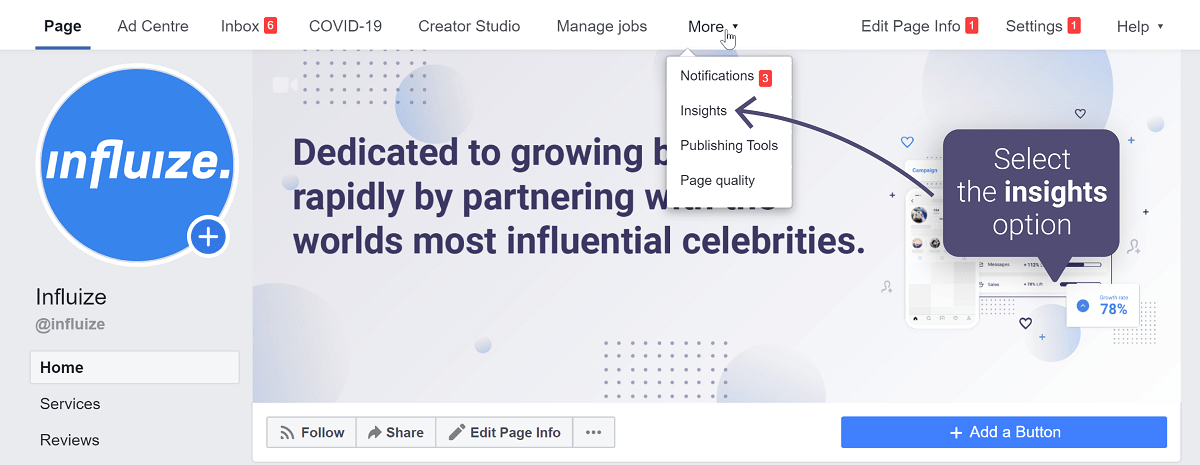
From here you’ll need to select ‘Posts’ from the menu to the left:
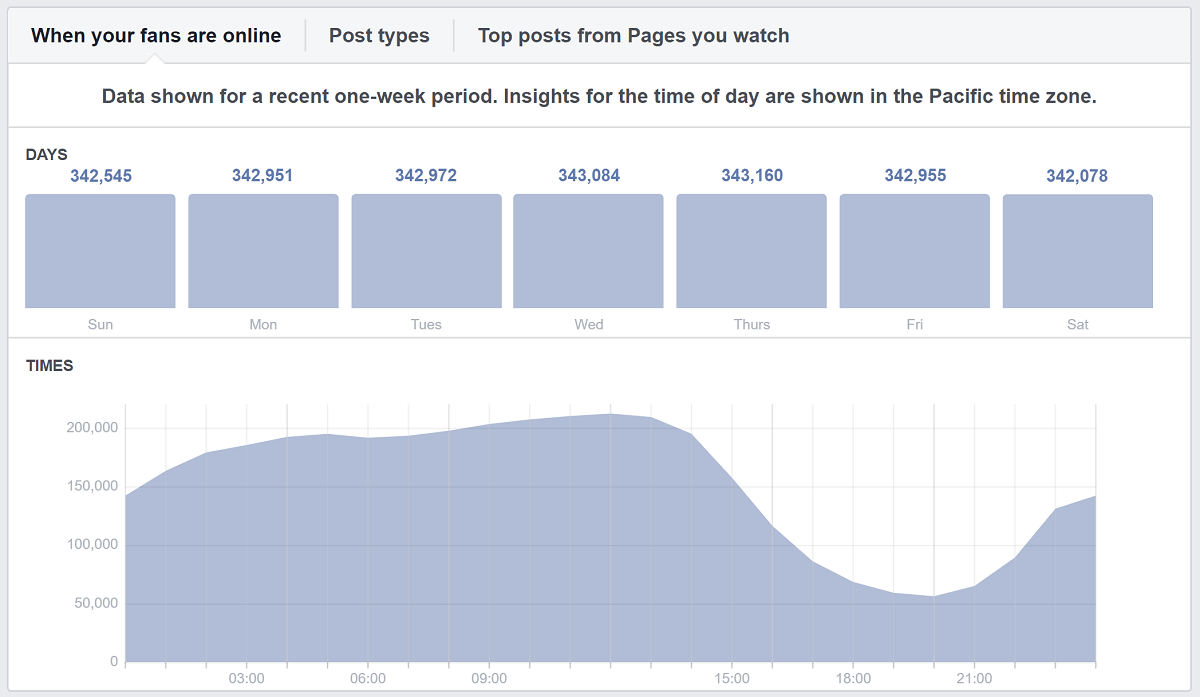
Your insights page should default to When Your Fans Are Online, but if it doesn’t make sure you tap the tab at the top. This page gives us all of the data we’ll need to begin to make changes to our posting schedule.
Another way to do this is to go to analytics.facebook.com and use the dedicated analytics platform. From here you can set your timezone (Insights is only displayed in Pacific time, so you’ll need to convert it to your own time zone), and you’ll be presented with a really easy to see day and hour chart on your overview page detailing when your audience is active.
Here’s an example of what that chart will look like:
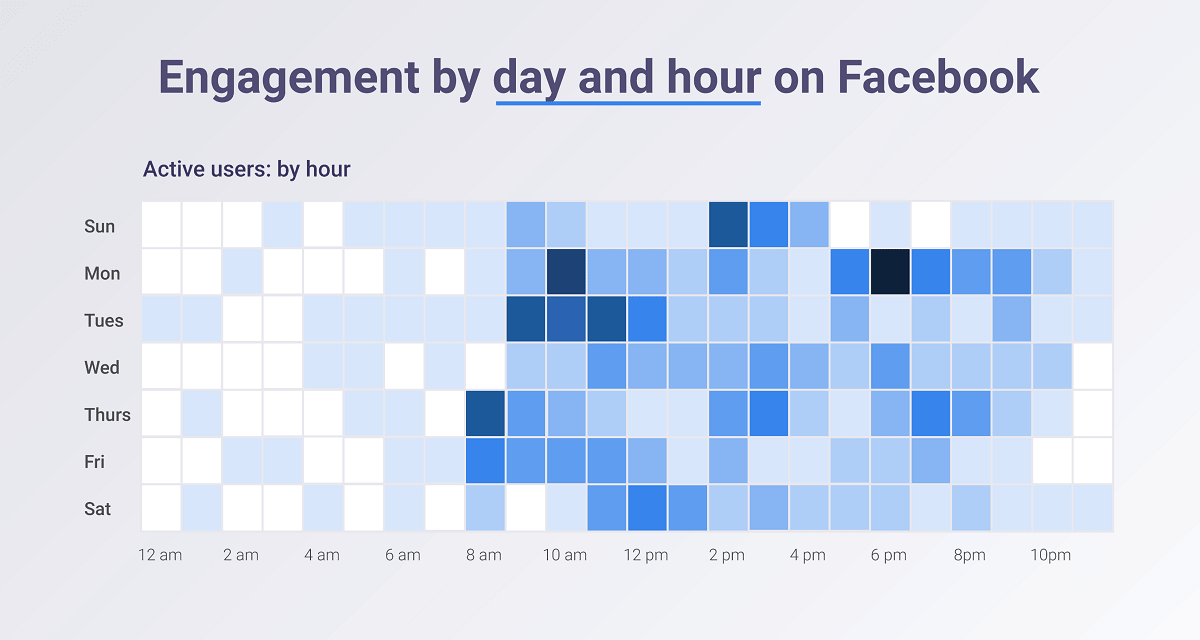
From this chart above, you can see that the audience is most active on:
- Sundays at 2 pm
- Mondays at 10 am and 6 pm
- Tuesdays between 9 am and 11 am
- They are not particularly active at all on Wednesdays
- There’s a peak at 8 am on Thursdays
- A small peak at 8 am on Fridays
- Saturdays is quite a quiet day with a small peak between 10 am and 1 pm
If we use this chart as an example again, we can really start to build a picture of when the best time to post for our OWN audience may be. If the content creator on this account only had time to create four pieces of content per week, we’d suggest they aimed to create a schedule that looked like this:
- Sunday at 2 pm
- Monday at either 10 am or 6 pm
- Tuesday at either 9 am or 11 am
- Thursday at 8 am
This schedule would mean that posts were released at the time that the target audience was specifically online and ready to receive the post in their newsfeed.
What to post on Facebook
So is it really that simple? Well, in a word, no. It’s not!
We discussed in one of our earlier blogs about posting to Instagram the idea of ‘audience value.’ How we can track our posts to ensure that, as well as gain the most views, we can tailor our content and our schedule to ensure that the right type of content is put towards the right people. Or in other words, valuable content gets us the return on investment that we’re after.
Tracking this is a bit more tricky, and it does mean understanding how Facebook views content. It would be simple just to say, “I want to increase landing page clicks, so 100% of all of my posts will be links to my website”. While this would probably increase landing page views in the short term, in the long term, Facebook will not view your page kindly for taking traffic away from Facebook.
The Rules of ‘Meaningful’ Engagement
Facebook has a mission. Their mission is to “bring the world closer together,” and they are doing that by promoting content that they deem creates meaningful engagement or more engagement on Facebook other than just clicks away.
They have come under fire in recent years for doing psychological experimenting with the news feed in a manner that was deemed unethical, but it does show that, even back in 2014, Facebook was concerned about the engagement users were creating on Facebook, and things began to change.
Since the famous 2018 algorithm update, Facebook has put more focus on posts that create engagement with the users. They understand that businesses and brands will want to send their audience to landing pages. However, they would prefer it if, for the most part, users stayed on Facebook, so a good mix of content that allows users to get involved by liking, commenting and sharing, is usually the best way to go.
Be warned: Facebook has begun downgrading content that they deem to be “clickbait” or “engagement-bait.” Links to websites with titles such as “His Wife Sent Him a Picture And He Rushed Home To See THIS!” will be deemed as clickbait, and posts that are designed along the lines of “To win: Like our page, tag a mate, and share this link” or “Which is better? Use your reaction buttons to let us know!” are also seen as engagement bait, where the brand is doing nothing valuable but clamouring for a response. Too many of these types of posts will see your reach and impressions start to go down.
Understanding Facebook Post Types
For a brand or business page, there are broadly 12 different types of posts you can create on Facebook. These are:
- A Video Post - Facebook loves video, they suggest that videos should be over 3 minutes long, but most brands find that videos that are 60-90 seconds work best
- A Video Post (with tagged products) - A video post specifically designed to advertise your products for sale, each product is tagged in the video
- A Photo Post - Sharing one (or more) photos to your timeline
- A Poll - A simple 2 option poll, you can use images, figs or text as your options
- A Status (with a feeling or activity) - A standard text status with a feeling or activity attached
- A Status (supporting a charity) - A standard test status with a link to support a particular charity attached
- A Status (with a link to get messages) - A text status with a large call to action for visitors to send you a message on Facebook Messenger
- A Status (with a location check-in) - A standard text status with a check in to a particular location
- A Live Video - A stand-alone option that allows pages or brands to “go live” on their page.
- A Multimedia Post - A status that allows either a photo album upload, a photo carousel, a slideshow or an instant experience
- A Watch Party - Upload a video and watch along “live” with your audience
- Adverts - Specific options for creating paid ads on your page
On top of these 12, you will also be able to create an Event, an Offer, or a Job post.
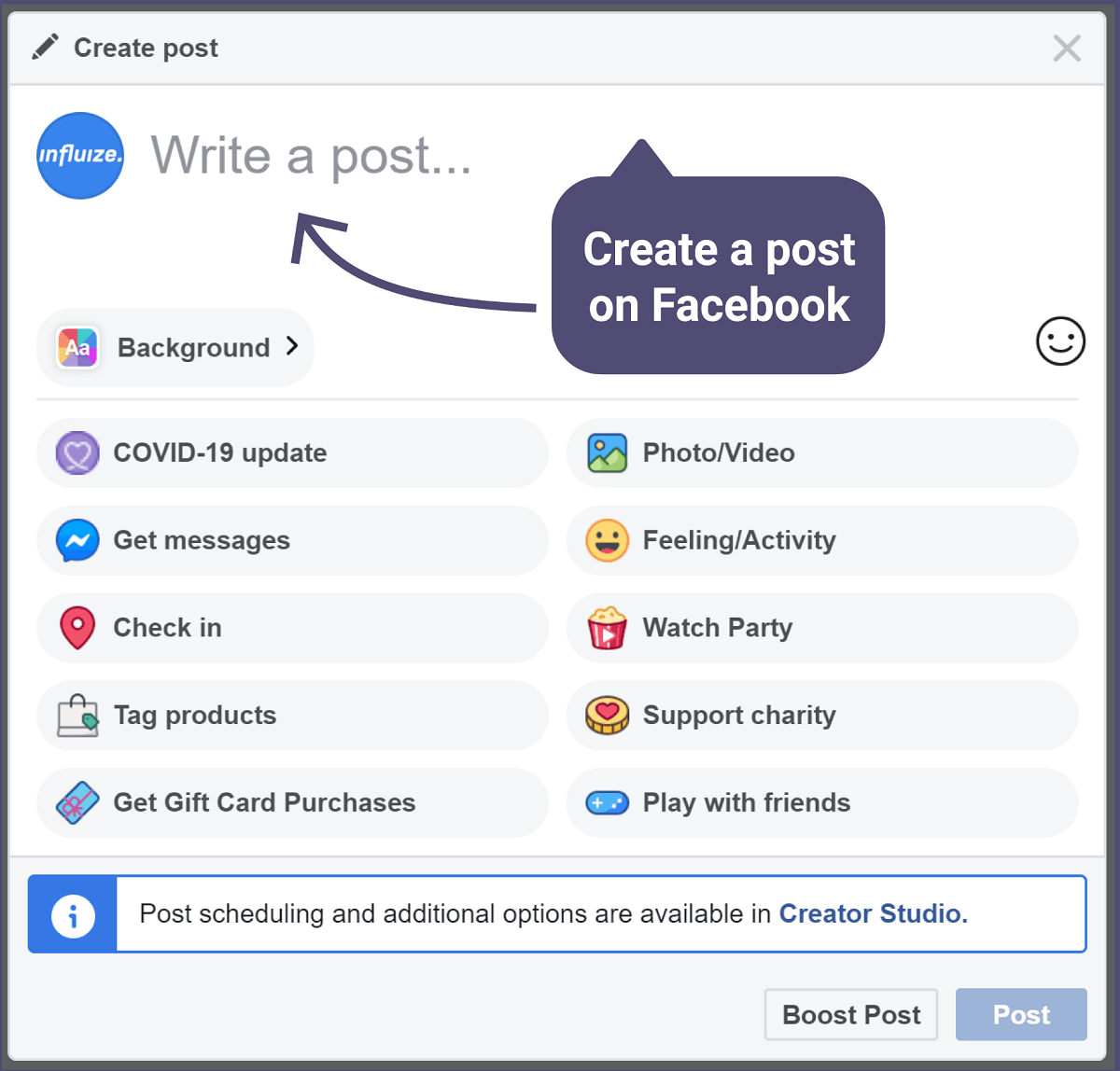
Many of these posts can be used in conjunction with another type of post. For example, you may wish to post a photo to your page, but the post might have text copy to accompany it along with a feeling, a check-in, and a link to support the charity of your choice.
There are a huge amount of options here, and the combination possibilities are seemingly endless.
A note about scheduling posts: Most third party scheduling assistant DO NOT allow for such a wide variety of posting options. It’s only using Facebook’s Creator Studio that you really can open up the floor to many different posting options and combinations or posting types.
Your Brand’s Post Types
As well as the different post types above, it’s important to begin to think about the different types of content you will be creating for your brand.
We’ve discussed in other blogs about the 80/20 rule - 80% non-promotional content, and 20% promotional content - and this is a great place to start when deciding what sort of content to post.
You may also want to come up with your own way of tagging content. We’d suggest planning your content ahead so you can see a great overview of how to categorise your content.
Here’s an example from a typical agency style spreadsheet content plan:

We’ve put the day to post on the left, followed by the date, the next column is a space for any special days such as Take Your Dog To Work Day (26th June, in case you were wondering!), the ‘post type’ column lets us know what the content mix looks like. There’s also space for the post’s copy, the URL, and the asset column to let us know what sort of media we’ll be attaching to this post.
The “post type” column is the important one here. This agency has categorised a number of posts for different formats. The client happens to be a veterinary practice; here’s a breakdown of what each post type means:
- Educational - These types of posts, for this client, are things like shareable infographics and links for educational purposes. Think of things like ‘what foods can you feed a cat?’ and ‘signs your dog is dehydrated,’ etc. These types of posts are designed to be educational while keeping the user on Facebook and encouraging them to share branded information with other Facebook users.
- Engagement - Engagement posts usually ask questions and ask the users to share their answers or pictures in the comments. Posts such as “Bailey was caught snoozing on the sofa, share with us some pics of your sleeping pets,” or perhaps, “What’s your favourite breed of dog? Let us know in the comments.” These types of posts are specifically designed to keep the user on Facebook and increase comments, likes, and shares.
- Blog - A link to the practice’s blog page where they share a new blog every two weeks. This is always a trackable URL (UTM) so that the social media manager can measure landing page views from Facebook specifically as opposed to Twitter, Instagram, or the email newsletter.
- 3rd Party Link - There’s a rule in social advertising that you should never promote just your own content, the third party links are usually trusted sources for fun or information. Examples might be a link to a pet crematorium website’s blog about how to speak to children about grief, or a link to a website with instructions to make DIY cat toys.
- Promo - These are usually promotional posts specifically. For this client, there are usually two types of promo, specific services (such as Puppy Socialisation Classes), or promotions on food or toys. The aim for these posts is usually either increasing footfall, increasing landing page views, or increasing sign-ups.
- Info - Info posts are not shown in this example, but the client uses info posts as intermittent posts to share specific relevant information to the audience with no planning. Usually, in the case of this veterinary client, it’s reserved for lost pets, information about deceased pets brought in after road accidents, telephone line issues, or a sudden change in opening hours.
- Brand Warmth - Another type of post that isn’t shown on this sheet, brand warmth posts are, in this example, good news stories from the practice that are not promotional in nature. Things such as thank you’s to clients for a box of chocolates or celebrating births, marriages, and exam passes for staff. Brand warmth posts are important to remind your audience that there are still humans behind the social page.
Creating Your Content Mix
How does knowing all of this information about content types help us to figure out when to post on Facebook, you may be asking? The beauty of knowing all of the information is that you can make informed decisions about what and when to post your content to get exactly the right amount of response and keep your account in good standing with Facebook.
It is, however, not quite as easy as using Facebook’s Analytics to get the answer, it will require a bit of manual digging.
We suggest that, in order to really understand when the best time to post is, you pull your data monthly and really analyse what you’ve been doing and what response you’ve been getting.
Here’s an example spreadsheet to track the numbers:

Here they’ve taken all of the data about our posts over a particular period, they’ve tagged them with our own content mix tags, and they’ve found out if they were campaign-related posts or not. As these posts have been going out through the Global Pandemic, they’ve paused all campaign posts because clients aren’t allowed in the practice right now and are putting a lot more focus into lighthearted engagement pieces rather than promotional pieces. Usually, this would be a good mix of campaign-related and not campaign-related.
On this sheet, they are also tracking who in the agency posted the piece of content to see who is most suited to working on the account.
This data can then be collected and analysed in a number of ways, such as by post type over October to December, and then January to March in the example below:
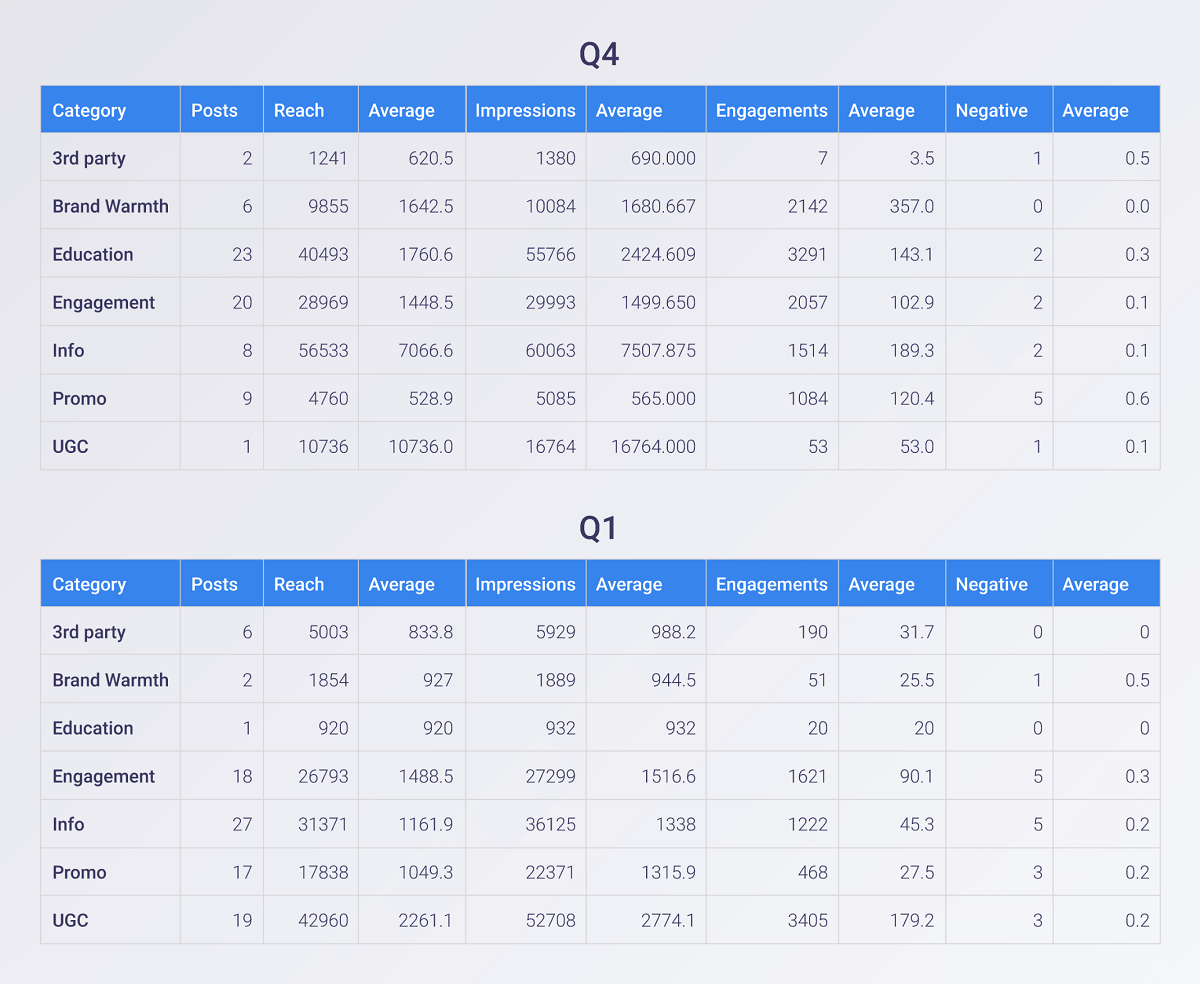
We’d suggest tailoring this approach to suit your page or brand best. You're then able to pivot your data on graphs to help visualise the data.
Facebook post reach

Facebook post impressions

Facebook post engagement rates
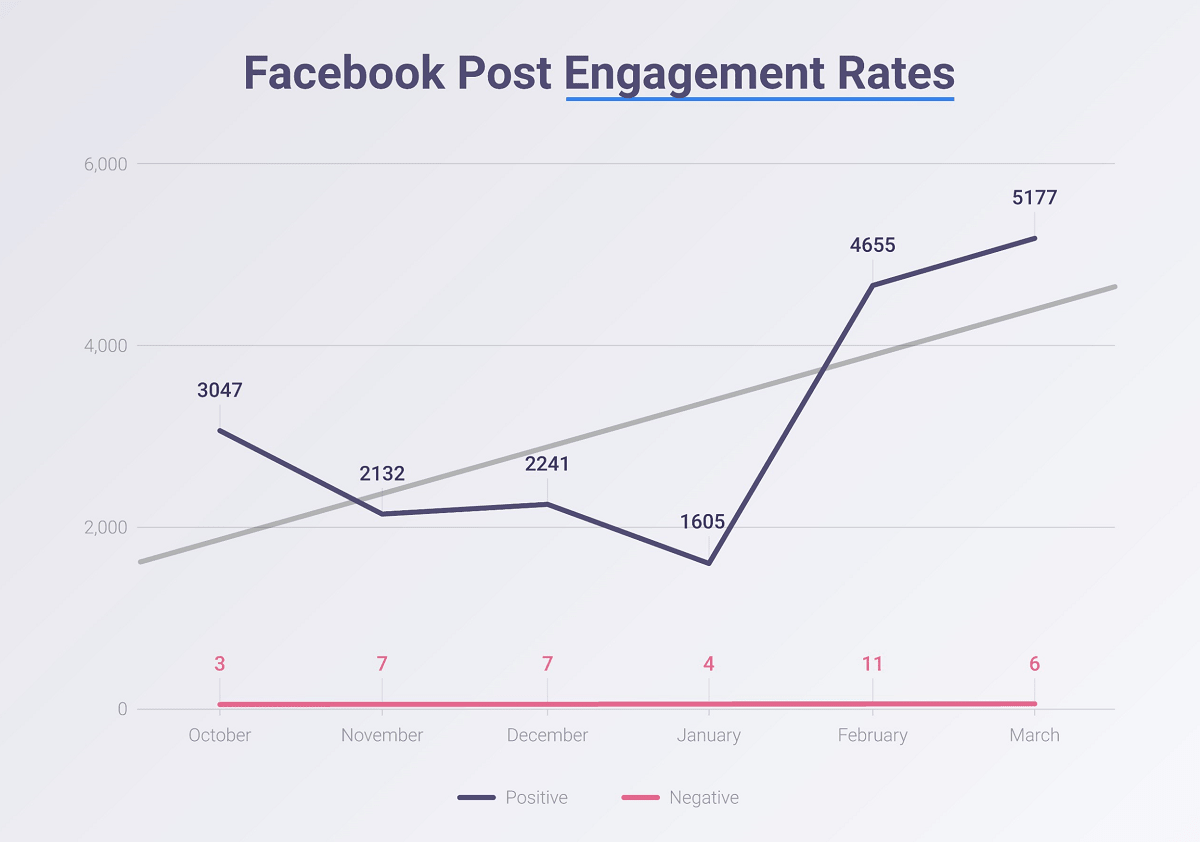
With all of this data collected, you can really start to see some correlations between what you post, when you post, and how it’s received. From here, you can begin to tailor your content mix to the right audience at the right time.
For example, you may find that your audience is really active at 2 pm on a Sunday, but it’s only really brand warmth posts that get the response. However, on Mondays at 6 pm, your audience is really interested in promotional posts from your page. Armed with this information, we can make sure the right post types go out to the right audience, so brand warmth on Sunday and promotional posts on Monday.
Creating and managing your content mix in this way works well for two important reasons:
- Facebook likes it - You will be able to mix up your posts so that you’re not always trying to send users away from Facebook. Facebook will be happy about this, and so will your audience. Remember, the more Facebook is happy with your content, the more likely the algorithm is to favour your posts about your competition.
- You don’t waste time - Social media has sometimes been described as like running on a treadmill, you can do a LOT of work and end up getting nowhere. While we see why this may be frustrating, in our opinion, it just shows that the work has been put in just in the wrong place. If you’re busy creating amazing promotional content, but you send it out on a day and time that your audience has shown a preference for engagement content, it’s not going to do as well as if you’d sent it out on a day that your audience has been more receptive to promotional content.
Of course, this isn’t an exact science, and it’s not a case of once learned it should stay that way forever. People change; your audience changes, and so your content should also change. So we’d always suggest keeping on top of things by doing regular checkups!
Really getting a handle on your content mix will allow you to make bigger decisions for your content too, such as how often to post on Facebook, the best time to post videos on Facebook and even the best times to do some page admin, such as the best time to upload a new Facebook profile picture.
How to schedule posts
Does it feel like we’re almost there? Now we know the best time to post on Facebook and the
worst times to post on Facebook for your brand, we’re going to figure out just how to post on Facebook, and don’t worry, this bit is fairly easy!
We plan to go into this a bit deeper in a later blog, so keep an eye out on our blogs page for the article, but we’ll briefly touch on it here.
There are two main ways to post on Facebook: Directly and via a scheduling assistant.
Direct posts are easy, you go to your page from either a browser or the app, and you post a status just as you would on your own personal profile page. You’ll have most of the same options open yo you as you would if you were using Facebook Creator Studio, as well as a few extra options. Right now, most pages will have the option to post a COVID-19 related update, for example.
Using a scheduling assistant is the way many agencies and professional social media managers prefer to work and, if you’re serious about really sorting out your Facebook page, we’d suggest you use a scheduling assistant too.
Scheduling assistants come in many different shapes, sizes, and price ranges, but they all work in a very similar way to one another, and most work cross-platform, and cross-operating system. This means you can sign up for one scheduling assistant and use it for Facebook, Instagram, Twitter, LinkedIn, and some even do Pinterest scheduling.
Some great options for scheduling assistants are:
- Buffer - Really well laid out, user-friendly, excellent customer support and well priced.
- Zoho Social - Part of Zoho’s wider CRM services, another great price and user-friendly option.
- Hootsuite - Probably the oldest and most well-known scheduling assistant, it can get quite expensive, and the user interface has seen better days.
- Facebook Creator Studio - The most flexible option for Facebook and Instagram, allowing all posting types and scheduling. It’s free, has an attractive (if a bit clunky) user interface, and gives some analytics feedback.
Some scheduling assistants purport to know the ‘best’ times to schedule your posts. By all means, give these a go, but we’d suggest still looking deeper into it for yourself to gain better insight for your own page or brand.
A Warning About Facebook Scheduling
We need to get really serious right now and give you a very important and very clear warning about scheduling your posts ahead of time:
Never be afraid to pull a post that will not land very well due to outside influences.
We can’t stress this one enough. Sometimes, with the best will in the world, things can happen that are completely out of your control, and you may need to dive in and remove a scheduled post if you know it will land badly with your audience due to something external that is going on.
If you’re wondering exactly what we mean, consider this example: You have a shop selling products, and you have a post scheduled to go out Thursday afternoon at 2 pm about your “whirlwind sale!”, at any time this would be a really innocent post, but on Wednesday morning a tornado hits. Suddenly the word “whirlwind” isn’t going to land very well with your audience.
The fact of the matter is that you can’t predict the future, and you won’t be able to make all of your audience happy all of the time. Still, it’s up to the person who manages your social media accounts (or you, if you are that person) to keep an eye on the wider news and ensure that your posts are relevant and not likely to cause upset or to cause traffic for the wrong reasons.
Scheduling your posts is a good idea, and you should be doing it, but you need to take a flexible and agile approach to it and not be afraid to pull a post or replace it with something else entirely. Some brands even keep a few generic ideas aside for times like these, just so they have some content going out, but not content that will upset or offend, given the wider context.
In Summary
Ok, so you’ve learnt a lot so far about the best times to post on social media!
By now you should have nailed down a good time to post. However, you’ll also have learnt all about your content mix and how to tag your posts so that they mean something to your business. You will also have figured out what you want to post and what you’re hoping to achieve from it, and (if you’ve made it this far) you will have found out what the worst time to post is and have a very clear idea of when and why you should remove scheduled posts.
How are we feeling? We hope this blog has been really clear. Some of the examples may not seem relevant to your business, but if you look at your content wholistically, you’ll see that you can apply the principles laid out here to all of your content marketing.
Content marketing is considered to be one of the best ways to engage an audience; in fact, the content marketing funnel is an important concept to integrate into your business’s marketing plans. This is because it’s flexible and agile enough to suit the needs of both small businesses and huge multinationals, as well as being simple enough for the average person to understand.
Social media, and Facebook, in particular, plays an important part in the content marketing funnel and if you get it right from the outset, you’ve already put your business or brand in the right place to ensure you’re hitting more and more audience target touchpoints.
Understanding your audience, their wants, their needs, and their activities will really help you to shape your content so that you can create useful and meaningful content for your audience at the right time, every time.
Good luck!